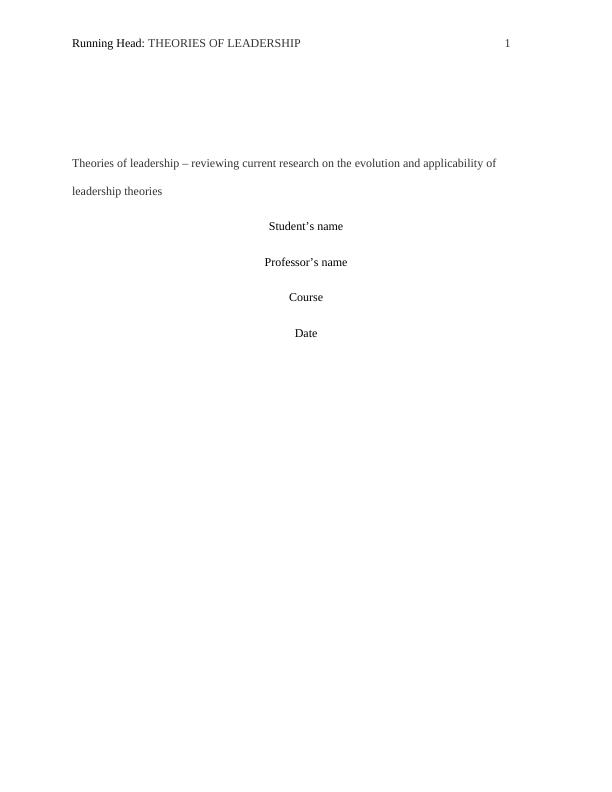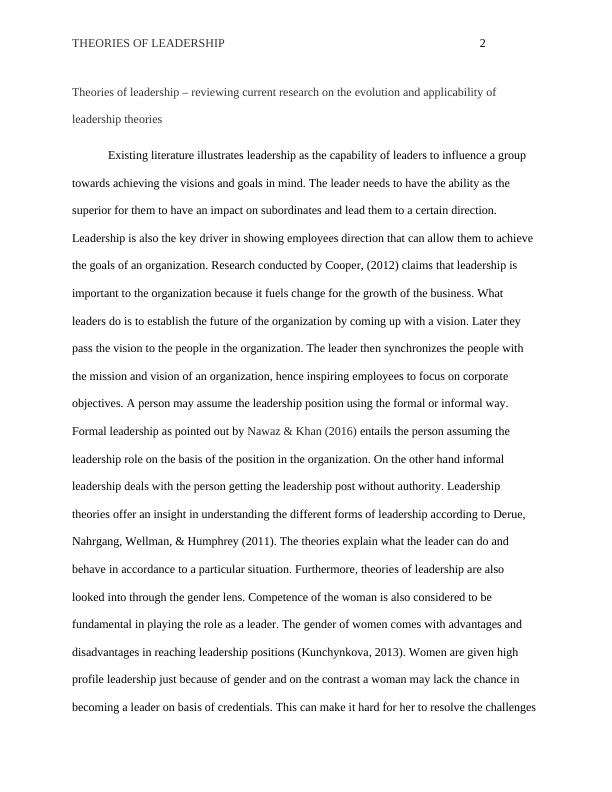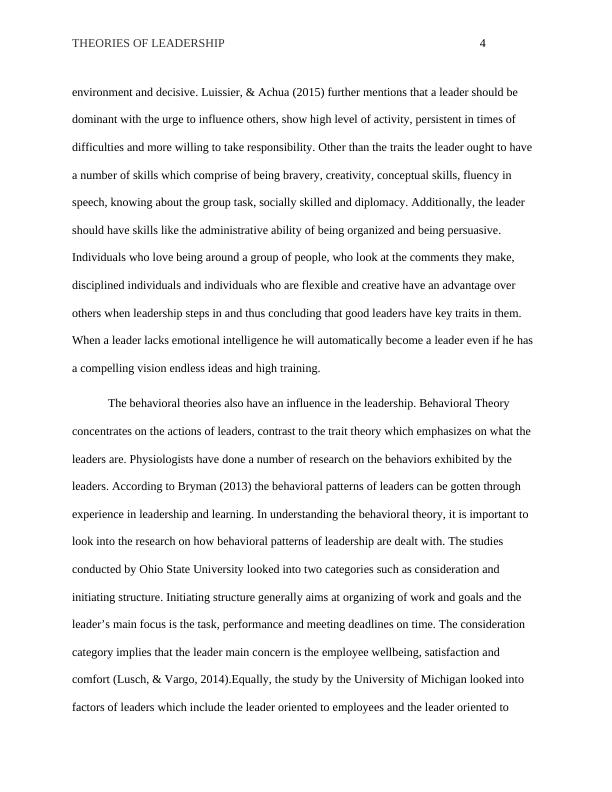Theories of Leadership: Reviewing Current Research on Evolution and Applicability
11 Pages3128 Words447 Views
Added on 2023-06-04
About This Document
This article reviews current research on the evolution and applicability of leadership theories, including the trait theory, behavioral theory, contingency theory, transactional theory, and transformational theory of leadership. It also explores the impact of gender on leadership and how leaders can continuously develop their skills.
Theories of Leadership: Reviewing Current Research on Evolution and Applicability
Added on 2023-06-04
ShareRelated Documents
Running Head: THEORIES OF LEADERSHIP 1
Theories of leadership – reviewing current research on the evolution and applicability of
leadership theories
Student’s name
Professor’s name
Course
Date
Theories of leadership – reviewing current research on the evolution and applicability of
leadership theories
Student’s name
Professor’s name
Course
Date

THEORIES OF LEADERSHIP 2
Theories of leadership – reviewing current research on the evolution and applicability of
leadership theories
Existing literature illustrates leadership as the capability of leaders to influence a group
towards achieving the visions and goals in mind. The leader needs to have the ability as the
superior for them to have an impact on subordinates and lead them to a certain direction.
Leadership is also the key driver in showing employees direction that can allow them to achieve
the goals of an organization. Research conducted by Cooper, (2012) claims that leadership is
important to the organization because it fuels change for the growth of the business. What
leaders do is to establish the future of the organization by coming up with a vision. Later they
pass the vision to the people in the organization. The leader then synchronizes the people with
the mission and vision of an organization, hence inspiring employees to focus on corporate
objectives. A person may assume the leadership position using the formal or informal way.
Formal leadership as pointed out by Nawaz & Khan (2016) entails the person assuming the
leadership role on the basis of the position in the organization. On the other hand informal
leadership deals with the person getting the leadership post without authority. Leadership
theories offer an insight in understanding the different forms of leadership according to Derue,
Nahrgang, Wellman, & Humphrey (2011). The theories explain what the leader can do and
behave in accordance to a particular situation. Furthermore, theories of leadership are also
looked into through the gender lens. Competence of the woman is also considered to be
fundamental in playing the role as a leader. The gender of women comes with advantages and
disadvantages in reaching leadership positions (Kunchynkova, 2013). Women are given high
profile leadership just because of gender and on the contrast a woman may lack the chance in
becoming a leader on basis of credentials. This can make it hard for her to resolve the challenges
Theories of leadership – reviewing current research on the evolution and applicability of
leadership theories
Existing literature illustrates leadership as the capability of leaders to influence a group
towards achieving the visions and goals in mind. The leader needs to have the ability as the
superior for them to have an impact on subordinates and lead them to a certain direction.
Leadership is also the key driver in showing employees direction that can allow them to achieve
the goals of an organization. Research conducted by Cooper, (2012) claims that leadership is
important to the organization because it fuels change for the growth of the business. What
leaders do is to establish the future of the organization by coming up with a vision. Later they
pass the vision to the people in the organization. The leader then synchronizes the people with
the mission and vision of an organization, hence inspiring employees to focus on corporate
objectives. A person may assume the leadership position using the formal or informal way.
Formal leadership as pointed out by Nawaz & Khan (2016) entails the person assuming the
leadership role on the basis of the position in the organization. On the other hand informal
leadership deals with the person getting the leadership post without authority. Leadership
theories offer an insight in understanding the different forms of leadership according to Derue,
Nahrgang, Wellman, & Humphrey (2011). The theories explain what the leader can do and
behave in accordance to a particular situation. Furthermore, theories of leadership are also
looked into through the gender lens. Competence of the woman is also considered to be
fundamental in playing the role as a leader. The gender of women comes with advantages and
disadvantages in reaching leadership positions (Kunchynkova, 2013). Women are given high
profile leadership just because of gender and on the contrast a woman may lack the chance in
becoming a leader on basis of credentials. This can make it hard for her to resolve the challenges

THEORIES OF LEADERSHIP 3
imposed on her. In addition, in evaluating leadership another focus shall be on how women face
few representations mainly in corporate management and finance sector. Essentially, women are
less favored in being elevated to leadership positions than men who have the same experience
and background. Based on the theories of leadership, Bass & Avolio, (1993) highlights them as
follows: the trait theory, the behavioral theory, the Contingency theory, the transactional theory
of leadership and the transformational theory of leadership.
Trait Theory is also known as Great Man Theory. To illustrate this theory, the analysis
will focus on leaders that have portrayed some exceptional leadership skills. Some strong leaders
of the past have been identified as great because of the traits they possessed. The examples of
such leaders include, Mahatma Gandhi, Margaret Thatcher, Nelson Mandela and Steve Jobs, the
apple founder. With focus on Margaret Thatcher, as the prime minister of Great Britain, she had
qualities like being confident, determined and iron-willed. By considering Margaret Thatcher
one can see how the trait theory underscores the personal characteristics and qualities that set the
boundary between leaders and non-leaders. Leaders are not born but are made according to the
trait theory. The concept behind the statement is largely referred to as ‘Great Man Theory’ of
leadership. Thomas Carlye proposed it in the year 1949 and an idea that great leaders will come
up, when there is need. Trait Theory also shows that a leader does not portray qualities of a
normal person and has to be different from the others. Derue, Nahrgang, Wellman, & Humphrey,
(2011) believes that a leader must portray personality traits that make them unique. Such traits
include perseverance, intelligence, knowledge, courage, determination, indefatigability and
ambition. Unfortunately, this theory only entails the male gender because women were not
considered during research. Generally, the traits essential for a leader requires them to leader to
adapt to situations, to bw very ambitious, cooperative with others, assertive, alert to the social
imposed on her. In addition, in evaluating leadership another focus shall be on how women face
few representations mainly in corporate management and finance sector. Essentially, women are
less favored in being elevated to leadership positions than men who have the same experience
and background. Based on the theories of leadership, Bass & Avolio, (1993) highlights them as
follows: the trait theory, the behavioral theory, the Contingency theory, the transactional theory
of leadership and the transformational theory of leadership.
Trait Theory is also known as Great Man Theory. To illustrate this theory, the analysis
will focus on leaders that have portrayed some exceptional leadership skills. Some strong leaders
of the past have been identified as great because of the traits they possessed. The examples of
such leaders include, Mahatma Gandhi, Margaret Thatcher, Nelson Mandela and Steve Jobs, the
apple founder. With focus on Margaret Thatcher, as the prime minister of Great Britain, she had
qualities like being confident, determined and iron-willed. By considering Margaret Thatcher
one can see how the trait theory underscores the personal characteristics and qualities that set the
boundary between leaders and non-leaders. Leaders are not born but are made according to the
trait theory. The concept behind the statement is largely referred to as ‘Great Man Theory’ of
leadership. Thomas Carlye proposed it in the year 1949 and an idea that great leaders will come
up, when there is need. Trait Theory also shows that a leader does not portray qualities of a
normal person and has to be different from the others. Derue, Nahrgang, Wellman, & Humphrey,
(2011) believes that a leader must portray personality traits that make them unique. Such traits
include perseverance, intelligence, knowledge, courage, determination, indefatigability and
ambition. Unfortunately, this theory only entails the male gender because women were not
considered during research. Generally, the traits essential for a leader requires them to leader to
adapt to situations, to bw very ambitious, cooperative with others, assertive, alert to the social

THEORIES OF LEADERSHIP 4
environment and decisive. Luissier, & Achua (2015) further mentions that a leader should be
dominant with the urge to influence others, show high level of activity, persistent in times of
difficulties and more willing to take responsibility. Other than the traits the leader ought to have
a number of skills which comprise of being bravery, creativity, conceptual skills, fluency in
speech, knowing about the group task, socially skilled and diplomacy. Additionally, the leader
should have skills like the administrative ability of being organized and being persuasive.
Individuals who love being around a group of people, who look at the comments they make,
disciplined individuals and individuals who are flexible and creative have an advantage over
others when leadership steps in and thus concluding that good leaders have key traits in them.
When a leader lacks emotional intelligence he will automatically become a leader even if he has
a compelling vision endless ideas and high training.
The behavioral theories also have an influence in the leadership. Behavioral Theory
concentrates on the actions of leaders, contrast to the trait theory which emphasizes on what the
leaders are. Physiologists have done a number of research on the behaviors exhibited by the
leaders. According to Bryman (2013) the behavioral patterns of leaders can be gotten through
experience in leadership and learning. In understanding the behavioral theory, it is important to
look into the research on how behavioral patterns of leadership are dealt with. The studies
conducted by Ohio State University looked into two categories such as consideration and
initiating structure. Initiating structure generally aims at organizing of work and goals and the
leader’s main focus is the task, performance and meeting deadlines on time. The consideration
category implies that the leader main concern is the employee wellbeing, satisfaction and
comfort (Lusch, & Vargo, 2014).Equally, the study by the University of Michigan looked into
factors of leaders which include the leader oriented to employees and the leader oriented to
environment and decisive. Luissier, & Achua (2015) further mentions that a leader should be
dominant with the urge to influence others, show high level of activity, persistent in times of
difficulties and more willing to take responsibility. Other than the traits the leader ought to have
a number of skills which comprise of being bravery, creativity, conceptual skills, fluency in
speech, knowing about the group task, socially skilled and diplomacy. Additionally, the leader
should have skills like the administrative ability of being organized and being persuasive.
Individuals who love being around a group of people, who look at the comments they make,
disciplined individuals and individuals who are flexible and creative have an advantage over
others when leadership steps in and thus concluding that good leaders have key traits in them.
When a leader lacks emotional intelligence he will automatically become a leader even if he has
a compelling vision endless ideas and high training.
The behavioral theories also have an influence in the leadership. Behavioral Theory
concentrates on the actions of leaders, contrast to the trait theory which emphasizes on what the
leaders are. Physiologists have done a number of research on the behaviors exhibited by the
leaders. According to Bryman (2013) the behavioral patterns of leaders can be gotten through
experience in leadership and learning. In understanding the behavioral theory, it is important to
look into the research on how behavioral patterns of leadership are dealt with. The studies
conducted by Ohio State University looked into two categories such as consideration and
initiating structure. Initiating structure generally aims at organizing of work and goals and the
leader’s main focus is the task, performance and meeting deadlines on time. The consideration
category implies that the leader main concern is the employee wellbeing, satisfaction and
comfort (Lusch, & Vargo, 2014).Equally, the study by the University of Michigan looked into
factors of leaders which include the leader oriented to employees and the leader oriented to

End of preview
Want to access all the pages? Upload your documents or become a member.
Related Documents
Women and Leadership Research Proposallg...
|8
|2038
|94
Role of Women in Leadership in Construction Project Managementlg...
|21
|4214
|46
Leadership Theories and Styleslg...
|5
|1418
|67
Report on Leadeship Style of Elon Musklg...
|11
|3551
|133
Theories of Leadershiplg...
|8
|2624
|49
Leadership and Management in Starbuckslg...
|11
|1102
|94
